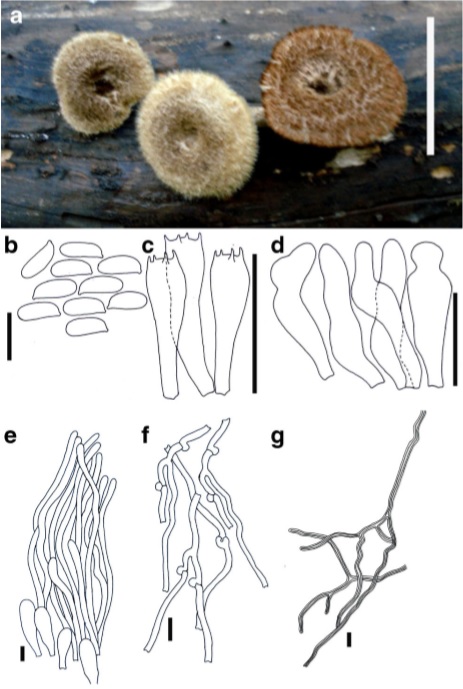Lentinus stuppeus Klotzsch [as ‘stuppens’], Linnaea 8(4): 480, 1833.
≡ Pocillaria stuppea (Klotzsch) Kuntze [as ‘stupea’], Revis. gen. pl. (Leipzig) 2: 866, 1891.
≡ Panus stuppeus (Klotzsch) Pegler & R.W. Rayner [as ‘stupeus’], Kew Bull. 23(3): 385, 1969. Facesoffungi number: FoF 02054.
Basidiomes very small to medium. Pileus 1–5.5 cm in diam., coriaceous, deeply umbilicate to deeply infundibuliform; margin inflexed, entire, thin at first reflexed, surface mahogany red, dark purplish brown to almost black, dry, densly villose, covered with curled, hispid, fibrillose hairs up to 7–8 mm long, glabrescent and finely rimose at the centre; margin strongly and persistently involute, densely pilose. Lamellae short decurrent, usually with some anastomosing at the stipe apex, pale yellowish buff, narrow, up to 3–4 mm wide, moderately crowded, with 4–5 tiers of lamellulae, edge strongly denticulate. Stipe 1.5–4.5 cm×2–4.5 mm, central, rarely lateral, cylindrical, slender, solid, expanding above, surface dull yellowish brown, often with deeply purple tints, covered by cinnamon brown tomentum at the apex, elsewhere with small, blackish, apprised squamules becoming hispid at the base; context 2–3 mm, white to dull white in colour, fibrous, consisting of a dimitic hyphal system with generative and skeletal hyphae. Generative hyphae 2–4μm diam., hyaline, very thin walled, frequently branched, with prominent clamp connexions. Skeletal hyphae 3–7μm diam., hyaline with a thickened wall, with wide dichotomous branching. Spore print cream colour. Basidiospores 6 – 9×2.3–3.4μm [n=30, (7.5×2.8μm), Q=2.78], cylindric, hyaline, thin walled. Basidia 20 –24×5–6.5μm, clavate, bearing 4 sterigmata. Lamella-edge sterile. Cheilocystidia 16 –36×4–8μm, sinuous clavate, hyaline, thin-walled. Hyphal pegs abundant. Hymenophoral trama hyaline, irregular, similar to context. Subhymenial layer narrow. Pileipellis an epicutis, with reddish brown walls. Hairs comprising fascicles of unbranched hyphae, with thickened, pigmented wall.
Habitat: On dead wood, in clusters, in rain forest dominated by Castanopsis armata, andLithocarpus sp.
Material examined: THAILAND, Chiang Mai Prov., Mae Taeng Dist., Ban Pha Deng village, N19°17.123′ E 98°44. 009′, elev. 900 m, rainforest dominated by Castanopsis armata and Pinus kesiya. 18 June 2013, (MFLU 10–0667).
Distribution: Ghana, Nigeria, West Cameroons, Zaire Republic, Uganda, Kenya, Madagascar, Mauritius, Zimbabwe, South Africa (Pegler 1986), new record to Thailand.

Phylogeny of Lentinus stuppeus and related species in the genus based on nrITS sequences, inferred by maximum likelihood (ML) analysis. Numbers at internodes refer to confidence estimates based on 100 rapid ML bootstraps (only those >50 are indicated). Lentinus stuppeus from Thailand is in blue. Leucoagaricus barssii and Leucoagaricus leucothites are outgroup taxa

